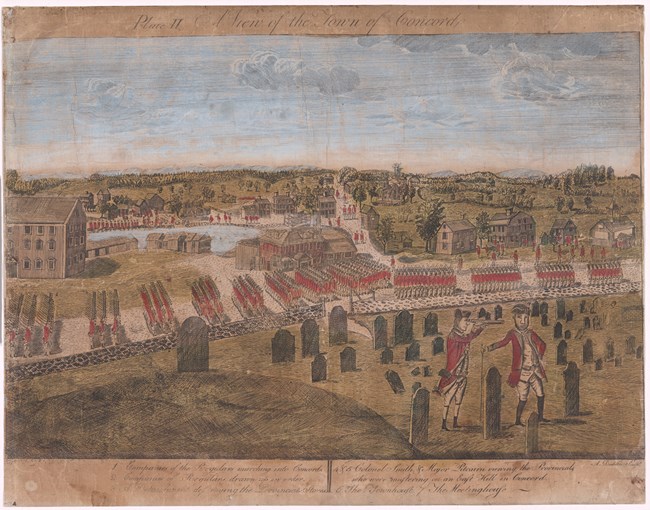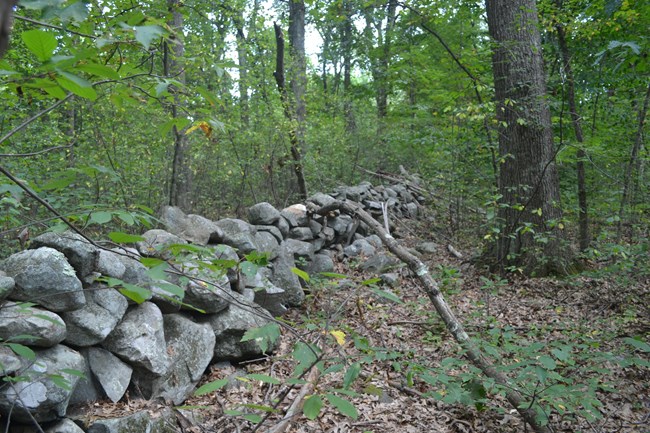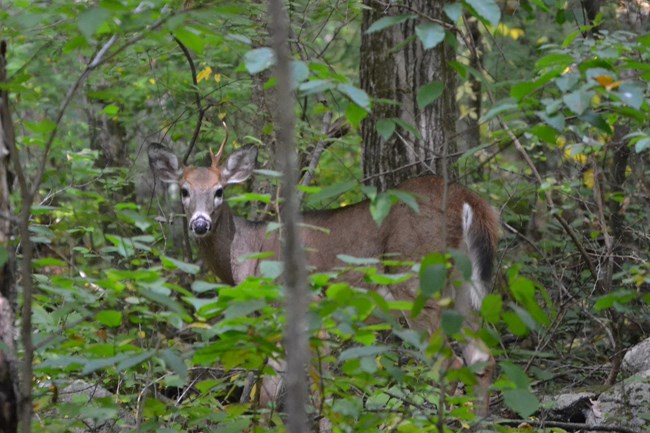Last updated: October 31, 2020
Article
Forests at Minute Man NHP

NPS photo
Through time and change, the forests of Concord, Massachusetts have influenced the development of a young nation. The forests sustained Indigenous peoples and were sought after for their economic use by early colonists. Despite their near eradication, they influenced great American authors and rebounded into the 21st century. Today, despite widespread coverage, the forests continue to face challenges.
Old Forest
Concord was probably settled by colonists for the same reasons its Indigenous inhabitants settled the area millenia prior. It sits near the convergence of two rivers, and is underlain by fertile glacial soil. Here, the colonists found a forest that been managed for at least a thousand years before colonial settlement. The native peoples of Musketaquid, what is now known as Concord, optimized forest resources through controlled burns to enhance agriculture practices, living areas, desirable native species and foraging game.
The forests of pre-colonial southern New England were therefore a mosaic of forest types in diverse developmental stages with high plant diversity. Animals such as deer, elk, moose, wolf, bear and beaver would have been present in the 17th-century forests of New England.

Image courtesy of the New York Public Library
Clearing land
Colonists replicated their European way of life, centering homes around a common meeting house and clearing forest around the settlement. Subsistence farming and animal husbandry sustained the early families. A heavy demand for fuel, clear plots of land, and lumber put pressure on local forests. It is estimated that each family needed 61 tons of wood per year. Concord, which had been 90% forested in 1635, was only 70% forested by 1700.
As Concord grew in population, this trend continued. In 1775, during the battle of Lexington and Concord, the town was only 30% forested, with large tracts of land cleared for agriculture. By the mid-19th century, only 10% of Concord was covered with forest. The Concord that Thoreau in the 19th century knew was much different than the Concord of pre-Colonial settlement, and even the Concord of today.

NPS photo
This took place in a series of successional stages. First, the hardy seeds of white pine colonized much of the abandoned agricultural areas. These monoculture forests were then populated with young hardwoods that established themselves among the stands of white pine. Forest development over 100 years has led to a diversity in tree ages and types.
Forest Development at MIMA


Left image
The Minute Man boulder once stood in a clearing of trees.
Credit: NPS photo
Right image
Approximately 50 years of forest development has swallowed the once clear meadow which the boulder stood in.
Credit: NPS photo

Modern forests
Today, the park is approximately 50-60% forested. The land cover over the 1,040 acres of park land alternates between forest, open grassland, swamp, and urban development. As with many successional forests of New England, the forests of Minute Man are composed primarily of hardwoods, with maples, oaks, ashes, and birch dominating the landscape. Minor stands and interspersed white pine and other conifers are present, as well.
Some, but not all animals have returned to the forests of Concord. Commonly spotted are whitetail deer, coyote, fox and beaver. Evidence of bear has also been observed. The wolf, elk and moose have not returned.
Red Maple (Acer rubrum)
Sugar Maple (Acer saccharum)
Bur Oak (Quercus macrocarpa)
Swamp White Oak (Quercus bicolor)
Northern Red Oak (Quercus rubra)
White Oak (Quercus alba)
Black Oak (Quercus veluntia)
American Elm (Ulmus americana)
White Ash (Fraxinus americana)
Green Ash (Fraxinus pennsylvanica)
Sweet Birch (Betula lenta)
Black Cherry (Prunus serotine)
American Beech (Fagus grandifolia)
White Spruce (Picea glauca)
Eastern White Pine (Pinus strobus)
....And many more.
Because cleared land could revert to forest beginning 170-100 years ago, many forest areas of New England are reaching a later successional stage, where extensive stands of white pine have given way to hardwoods, diverse in age and species. Despite the return of forests, the forest we see today is not identical to pre-colonial forests. There are challenges facing New England’s forests.
Special concerns
The forests of Minute Man face several challenges because of prior colonial clear cutting and urban influence.
One of the most glaring issues facing the forests of Southern New England, and Minute Man in particular, is the presence of invasive species and their effect on the landscape. Fast-spreading shrubs like glossy buckthorn make it difficult for native plant species to establish themselves. Unfortunately, the disturbed nature of the landscape makes it easier for invasives to take hold and spread.
Further Reading:
Foster, Charles H. W. Stepping Back To Look Forward. Harvard Forest, 1998.
Historic Resources Masterplan of Concord, Massachusetts (Concord: Concord Historical Commission, 2001), pages 13-22
Kelso, Gerald. (2014). Colonial Era Land Clearance Inferred from Soil Pollen Analysis: A Massachusetts Case Study. North American Archaeologist. 35. 37-54. 10.2190/NA.35.1.b.
James-Pirri, M.-J. August 2009. Natural Resource Assessment for Minute Man National Historical Park. Technical Report NPS/NER/NRTR—2009/141. National Park Service. Boston, MA.
Miller KM and Seirup C. 2018. NETN Forest health monitoring in Minute Man NHP: 2006-2018 summary. National Park Service. Fort Collins, Colorado
The Miriam and Ira D. Wallach Division of Art, Prints and Photographs: Print Collection, The New York Public Library. 1775. "Plate II. A view of the town of Concord" The New York Public Library Digital Collections. http://digitalcollections.nypl.org/items/510d47d9-7eae-a3d9-e040-e00a18064a99
